AWM41 969 - [Nurses Narratives] Sister G Douglas - Part 1
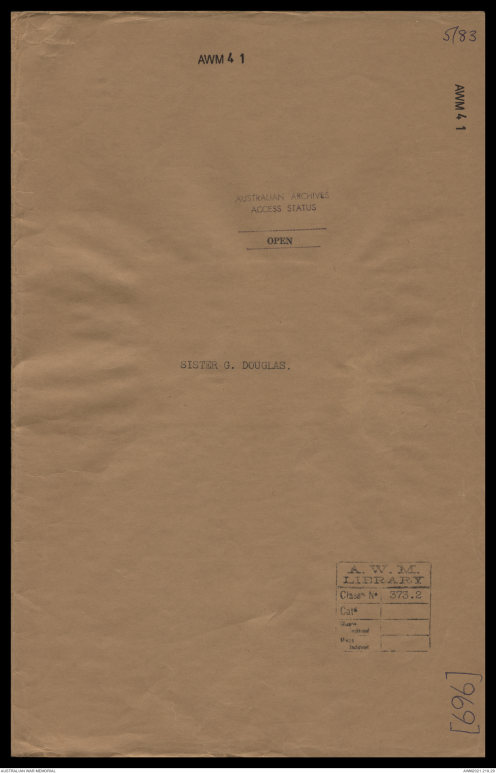
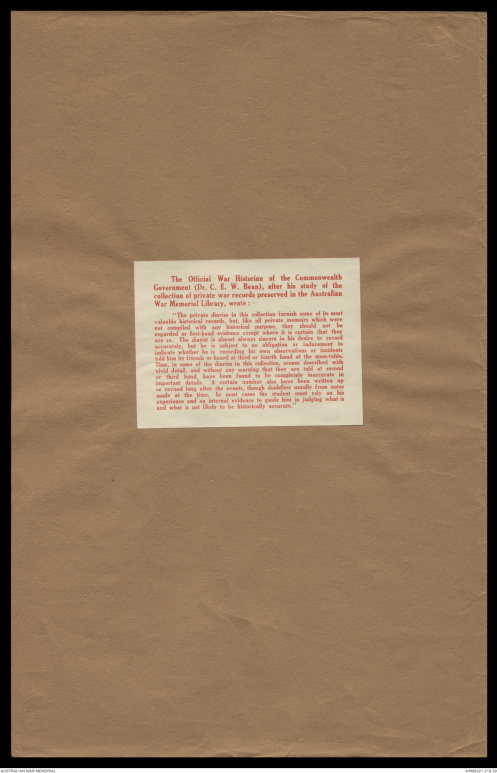
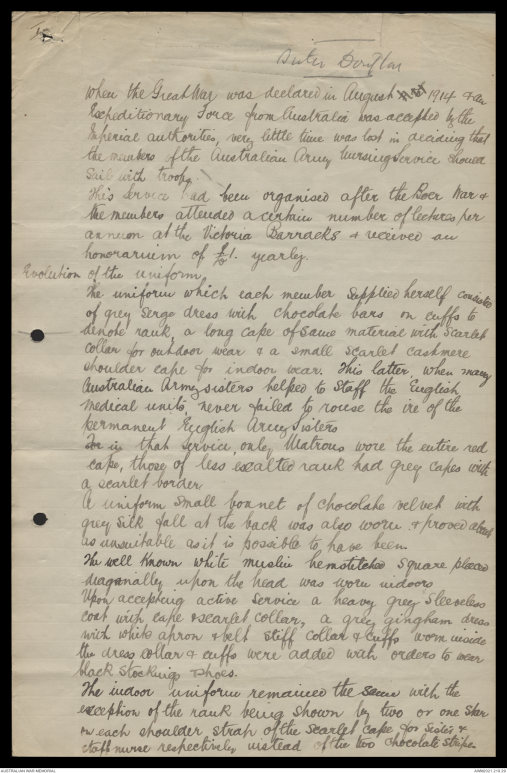
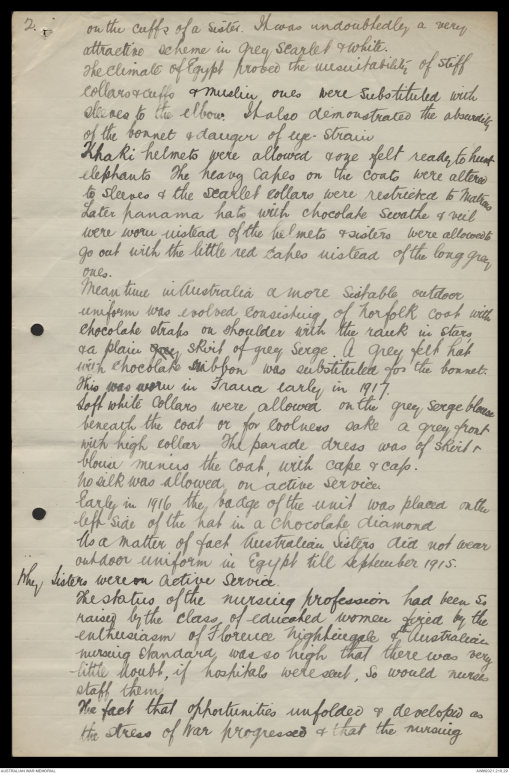
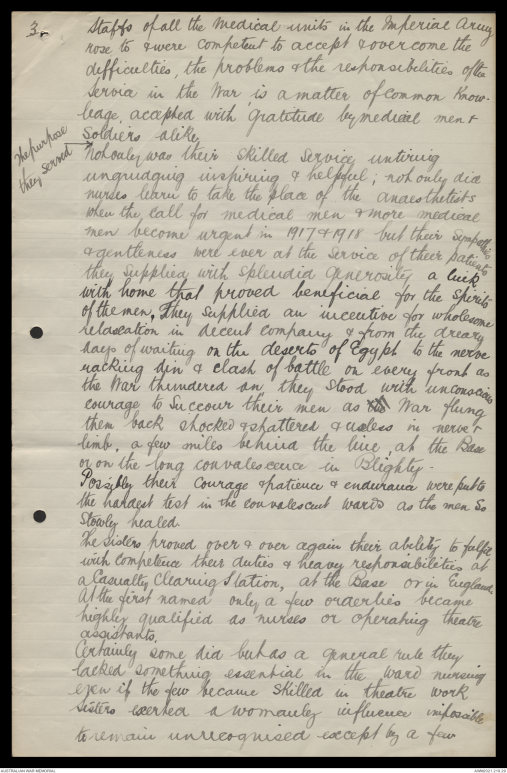
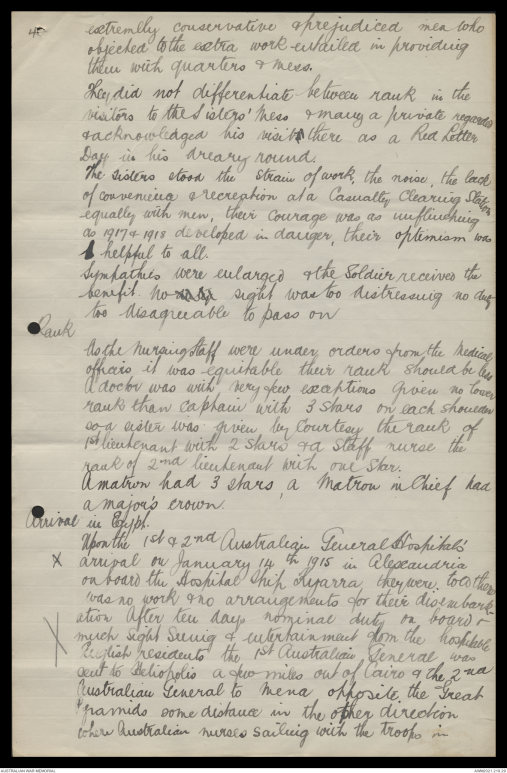
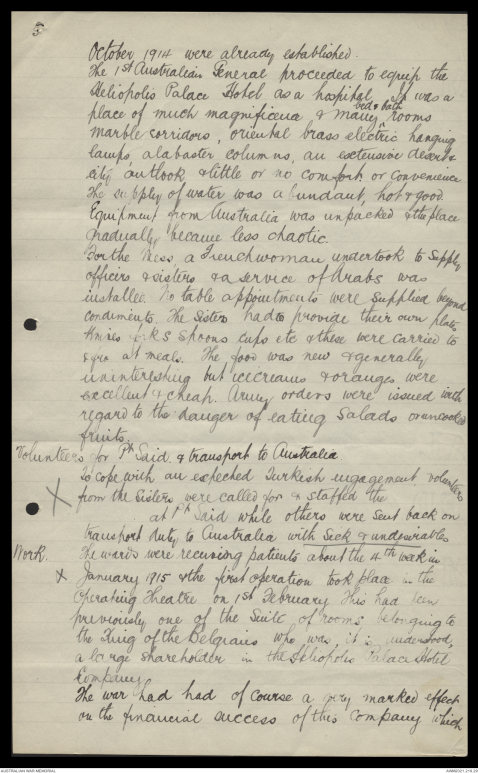
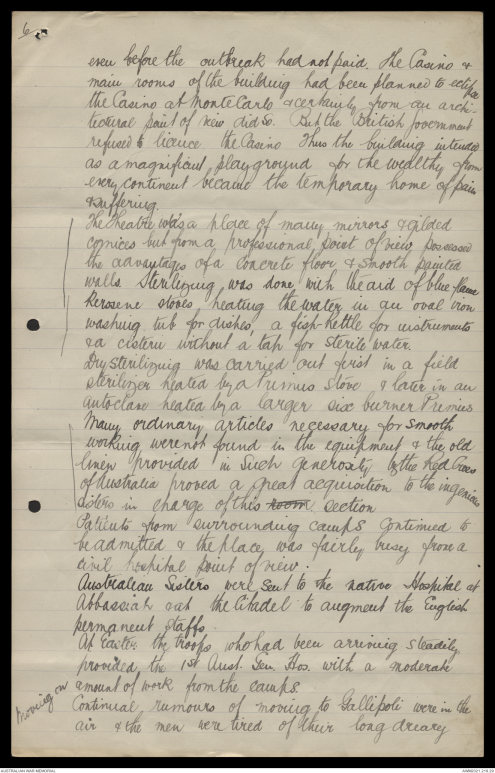
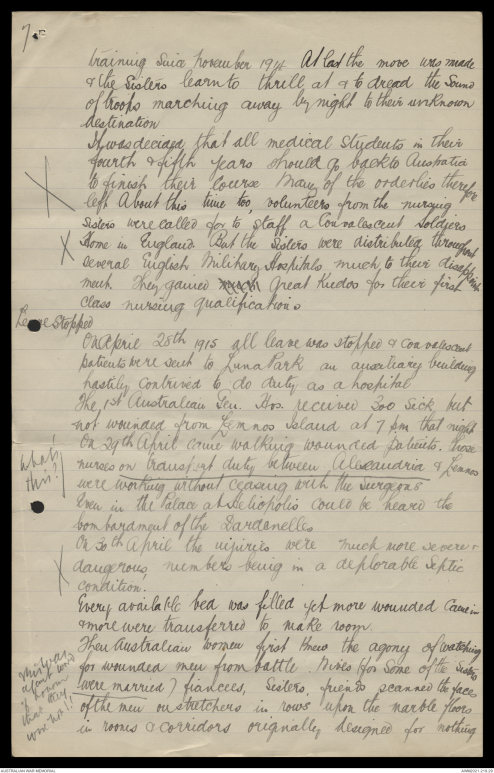
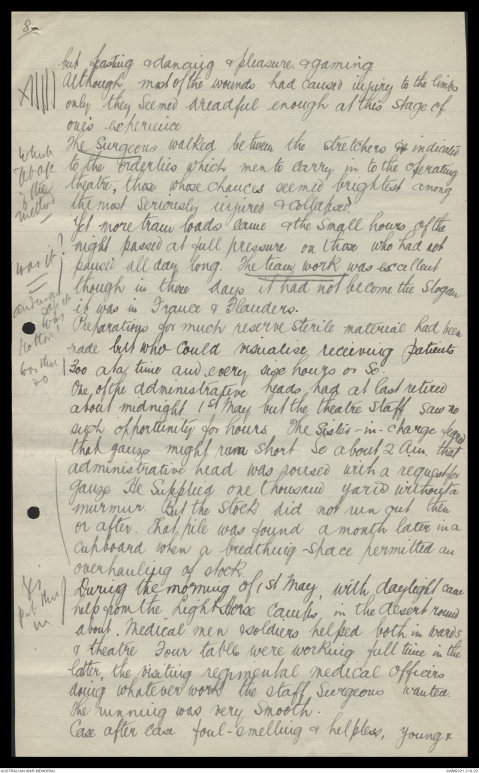
5/83
AWM 4 1
AWM 4 1
AUSTRALIAN ARCHIVES
ACCESS STATUS
OPEN
SISTER G. DOUGLAS.
A.W.M.
LIBRARY
Classn No 373.2
Cat
[[?]]
[[?]]
[969]
The Official War Historian of the Commonwealth
Government (Dr. C. E. W. Bean), after his study of the
collection of private war records preserved in the Australian
War Memorial Library, wrote:-
"The private diaries in this collection furnish some of its most
valuable historical records, but, like all private memoirs which were
not compiled with any historical purpose, they should not be
regarded as first-hand evidence except where it is certain that they
are so. The diarist is almost always sincere in his desire to record
accurately, but he is subject to no obligation or inducement to
indicate whether he is recording his own observations or incidents
told him by friends or heard at third or fourth hand at the mess-table.
Thus, in some of the diaries in this collection, scenes described with
vivid detail, and without any warning that they are told at second
or third hand, have been found to be completely inaccurate in
important details. A certain number also have been written up
or revised long after the events, though doubtless usually from notes
made at the time. In most cases the student must rely on his
experience and on internal evidence to guide him in judging what is
and what is not likely to be historically accurate".
1.
Sister Douglas
when the Great War was declared in August 4th 1914 & an
Expeditionary Force from Australia was accepted by the
Imperial authorities, very little time was lost in deciding that the
the members of the Australian Army Nursing Service should
sail with troops.
This Service had been organised after the Boer War &
the members attended a certain number of lectures per
annum at the Victoria Barracks & received an
honorarium of £1. yearly.
Evolution of the uniform.
The uniform which each member supplied herself consisted
of grey serge dress with chocolate bars on cuffs to
denote rank, a long cape of same material with scarlet
collar for outdoor wear & a small scarlet cashmere
shoulder cape for indoor wear. This latter, when many
Australian Army sisters helped to staff the English
medical units, never failed to rouse the ire of the
permanent English Army Sisters
For in that Service, only Matrons wore the entire red
cape, those of less exalted rank had grey capes with
a scarlet border.
A uniform small bonnet of chocolate velvet with
grey silk fall at the back was also worn & proved about
as unsuitable as it is possible to have been.
The well known white muslin hemstitched square pleated
diagaonally upon the head was worn indoors
Upon accepting active service a heavy grey sleeveless
coat with cape & scarlet collar, a grey gingham dress
with white apron & belt stiff collar & cuffs worn inside
the dress collar & cuffs were added with orders to wear
black stockings & shoes.
The indoor uniform remained the same with the
exception of the rank being shown by two or one star
on each shoulder strap of the scarlet cape for sister &
staff nurse respectively instead of the two chocolate stripes
2.
on the cuffs of a sister. It was undoubtedly a very
attractive scheme in grey scarlet & white.
The climate of Egypt proved the unsuitability of stiff
collars & cuffs & muslin ones were substituted with
sleeves to the elbow. It also demonstrated the absurdity
of the bonnet & danger of eye-strain
Khaki helmets were allowed & one felt ready to hunt
elephants The heavy capes on the coats were altered
to sleeves & the scarlet collars were restricted to matrons
Later panama hats with chocolate swathe & veil
were worn instead of the helmets & sisters were allowed to
go out with the little red capes instead of the long grey
ones.
Mean time in Australia a more suitable outdoor
uniform was evolved consisting of Norfolk coat with
chocolate straps on shoulder with the rank in stars
& a plain grey skirt of grey Serge. A grey felt hat
with chocolate ribbon was substituted for the bonnet.
This was worn in France early in 1917.
Soft white collars were allowed on the grey serge blouse
beneath the coat or for coolness sake a grey front
with high collar The parade dress was of skirt &
blouse minus the coat, with cape & cap.
No silk was allowed on active service
Early in 1916 the badge of the unit was placed on the
left side of the hat in a chocolate diamond
As a matter of fact Australian Sisters did not wear
outdoor uniform in Egypt till September 1915.
Why Sisters were on Active Service.
The status of the nursing profession had been so
raised by the class of educated women fired by the
enthusiasm of Florence Nightingale & Australian
nursing standard, was so high that there was very
little doubt, if hospitals were sent, So would nurses
staff them
The fact that opportunities unfolded & developed as
the stress of War progressed & that the nursing
3.
staffs of all the medical units in the Imperial Army
rose to & were competent to accept & overcome the
difficulties, the problems & the responsibilities of the
Service in the War is a matter of common knowledge,
accepted with gratitude by medical men &
soldiers alike
[* The purpose they served*]
Not only was their skilled service untiring
ungrudging inspiring & helpful, not only did
nurses learn to take the place of the anaesthetists
when the call for medical men & more medical
men become urgent in 1917 & 1918 but their sympathies
& gentleness were ever at the service of their patients
they supplied with splendid generosity a link
with home that proved beneficial for the spirits
of the men, They supplied an incentive for wholesome
relaxation in decent company & from the dreary
days of waiting on the deserts of Egypt to the nerve
racking din & clash of battle on every front as
the War thundered on they stood with unconscious
courage to succour their men as the War flung
them back shocked & shattered & useless in nerve &
limb, a few miles behind the line, at the Base
or on the long convalescence in Blighty -
Possibly their courage & patience & endurance were put to
the hardest test in the convalescent ward as the men so
slowly healed.
The sisters proved over & over again their ability to fulfil
with competence their duties & heavy responsibilities at
a Casualty Clearing Station, at the Base or in England.
At the first named only a few orderlies became
highly qualified as nurses or operating theatre
assistants.
Certainly some did but as a general rule they
lacked something essential in the ward nursing
even if the few became skilled in theatre work
Sisters exerted a womanly influence impossible
to remain unrecognised except by a few
4.
extremely conservative & prejudiced men who
objected to the extra work entailed in providing
them with quarters & mess.
They did not differentiate between rank in the
visitors to the Sisters' Mess & many a private regarded
& acknowledged his visits there as a Red Letter
Day in his dreary round.
The Sisters stood the strain of work, the noise, the lack
of convenience & recreation at a Casualty Clearing Station
equally with men, their courage was as unflinching
as 1917 & 1918 developed in danger, their optimism wash helpful to all.
Sympathies were enlarged & the Soldier received the
benefit. No doubt sight was too distressing no duty
too disagreeable to pass on
Rank
As the nursing staff were under orders from the medical
officers it was equitable their rank should be less
A doctor was with very few exceptions given no lower
rank than captain with 3 stars on each shoulder
so a sister was given by courtesy the rank of
1st lieutenant with 2 stars & a staff nurse the
rank of 2nd lieutenant with one Star.
A matron had 3 stars, a Matron in Chief had
a major's crown.
Arrival in Egypt
Upon the 1st & 2nd Australian General Hospitals
[*X*] arrival on January 14th 1915 in Alexandria
on board the Hospital Ship Kyarra, they were told there
was no work & no arrangements for their disembarkation
[*X*] After ten days nominal duty on, board &
much sight seeing & entertainment from the hospitable
English residents the 1st Australian General, was
sent to Heliopolis a few miles out of Cairo & the 2nd
Australian General to Mena opposite the Great
Pyramids some distance in the other direction
where Australian nurses sailing with the troops in
5
October 1914 were already established.
The 1st Australian General proceeded to equip the
Heliopolis Palace Hotel as a hospital. It was a
place of much magnificence & many ^bed & bath rooms
marble corridors, oriental brass electric hanging
lamps, alabaster columns, an extensive desert &
city outlook & little or no comfort or convenience.
The supply of water was a abundant, hot & good.
Equipment from Australia was unpacked & the place
gradually because less chaotic.
For the Mess, a Frenchwoman undertook to supply
officers & sisters & a service of Arabs was
installed. No table appointments were supplied beyond
condiments. The Sisters had to provide their own plates
knives forks spoons cups etc & these were carried to
& fro at meals. The food was new & generally
uninteresting but icecreams & oranges were
excellent & cheap. Army orders were issued with
regard to the danger of eating salads or uncooked
fruits.
Volunteers for Pt Said & transport to Australia
To cope with an expected Turkish engagement volunteers
[*X*] from the Sisters were called for & staffed the
at Pt Said while others are sent back on
transport duty to Australia with sick & undesirables
Work The wards were receiving patients about the 4th week in
[*X*] January 1915 & the first operation took place in the
Operating Theatre on 1st February This had been
previously one of the Suite of rooms belonging to
the King of the Belgians who was, it is understood,
a large shareholder in the Heliopolis Palace Hotel
Company
The war had had of course a very marked effect
on the financial success of this company which
6
even before the outbreak had not paid. The Casino &
main rooms of the building had been planned to eclipse
the Casino at Monte Carlo & certainly from an architectural
point of view did so. But the British government
refused to licence the Casino Thus the building intended
as a magnificent playground for the wealthy from
every continent became the temporary home of pain
& suffering.
The Theatre was a place of many mirrors &gilded
cornices but from a professional point of view possessed
the advantages of a concrete floor & smooth painted
walls. Sterilising was done with the aid of blue flame
kerosene stores, heating the water in an oval iron
washing tub for dishes, a fish kettle for instruments
& a cistern without a tap for sterile water.
Dry sterilizing was carried out first in a field
sterilizer heated by a Primus stove & later in an
autoclave heater by a larger six burner Primus
Many ordinary articles necessary for smooth
working were not found in the equipment & the old
linen provided in such generosity by the Red Cross
of Australia proved a great acquisition to the ingenious
sisters in charge of this room section
Patients from surrounding camps continued to
be admitted & the place was fairly busy from a
civil hospital point of view.
Australian Sisters were sent to the native Hospital
Abbassiah & at the Citadel to augment the English
permanent staffs.
At Easter the troops who had been arriving steadily
provided, the 1st Aust. Gen. Hos. with a moderate
amount of work from the camps.
[*Moving on *] Continual rumour of moving to Gallipoli were in the
air & the men were tired of their long dreary
7
training since November 1914 At last the move was made
& the Sisters learn to thrill at & to dread the sound
of troops marching away by night to their unknown
destination
It was decided that all medical students in their
fourth & fifth years should go back to Australia
to finish their course Many of the orderlies therefore
left About this time too, volunteers from the nursing
sisters were called for to staff a Convalescent Soldiers
Home in England. But the Sisters were distributed throughout
several English Military Hospitals much, to their disappointment.
They gained much great kudos for their first
class nursing qualifications
Leave Stopped
On April 20th 1915 all leave was stopped & convalescent
patients were sent to Luna Park an auxiliary building
hastily contrived t do duty as a hospital
The 1st Australian Gen. Hos. received 300 sick, but
not wounded from Lemnos Island at 7 p.m that night
[*What's this?*] On 29th April came walking wounded patients.
nurses on transport duty between Alexandria & Lemnos
were working without ceasing with the surgeons
Even in the Palace at Heliopolis could be heard the
bombardment of the Dardanelles
On 30th April the injuries were much more severe &
[*X*] dangerous, number being in a deplorable septic
condition.
Every available bed was filled yet more wounded Came in
& more were transferred to make room.
Then Australian women first knew the agony of watching
for wounded men from battle. /[[Wives?]]/ for some of the Sisters
[*This was
a[[part?]] word
if however
that they
were not!!*]
were married fiancees, Sisters, friends scanned the faces
of the new stretchers in rows upon the marble floors
in rooms & corridors originally designed for nothing
8
but feasting & dancing & pleasure & gaming.
[*X|||||*] Although most of the wounds had causes injury to the limbs
only they seemed dreadful enough at this stage of
one's experience
The Surgeons walked between the stretchers & indicated
to the orderlies which men to carry in to the operating
theatre, those whose chances seemed brightest among
the most seriously injured & collapsed.
Yet more train loads came & the small hours of the
night passed at full pressure on those who had not
[*Was it?
—
—
Austr?
say it
was Hotter*]
paused all day long. The team work was excellent
though in those days it had not become the slogan
it was in France & Flanders.
Preparations for much reserve sterile material had been
made but who could visualise receiving patient
[* was before then
so*]
300 at a time and every six hours or so.
One of the administrative heads, had at last retired
about midnight 1st May but the theatre staff saw no
such opportunity for hours. The Sister-in-charge feared
that gauze might run short so about 2 a.m. that
administrative head was roused with a request for
gauze He supplied one thousand yards without a
murmur But the stock did not run out then
or after. That pile was found a month later in a
cupboard when a breathing space permitted an
overhauling of stock.
[*Yes
put this
in*]
During the morning of 1st May, with daylight came
help from the Light Horse camps, in the desert round
about. Medical men & soldiers helped both in wards
& theatre Four tables were working full time in the
later, the visiting regimental medical officers
doing whatever work the staff surgeons wanted.
The running was very smooth.
Case after case foul-smelling & helpless, young &
 Sam scott
Sam scottThis transcription item is now locked to you for editing. To release the lock either Save your changes or Cancel.
This lock will be automatically released after 60 minutes of inactivity.